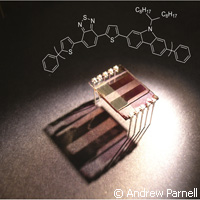'Cling-film' solar cells promise new age of renewable energy
To date, most photovoltaic devices have been made of silicon and have relied upon intricate nanostructures that require lots of time and effort to develop. But now British scientists say that plastic solar cells can be printed to create cling-film-like substances that can be 'spread' to make 'ultra-cheap solar energy panels for domestic and industrial use'. Specifically, plastic films can be deposited from solutions using low-cost roll-to-roll printing techniques. Some large circuits with thin-film transistors and other devices already use this technology. However, its efficiency needs to be improved from between 7 % and 8 % to at least 10 % to make it commercially viable. Scientists from the universities of Sheffield and Cambridge in the United Kingdom studied the structure and composition of certain polymers, using the ISIS neutron source and extremely bright X-rays at the Diamond Light Source facility of the Science and Technology Facilities Council (STFC) in Oxfordshire. The study, published in the journal 'Advanced Energy Materials', revealed that when complex mixtures of molecules in a solution were spread onto a surface, like varnishing a tabletop, the different molecules separate to the top and bottom of the layer, maximising the efficiency of the resulting solar cell. Dr Andrew Parnell of the University of Sheffield suggested that 'rather than using complex and expensive fabrication methods to create a specific semiconductor nanostructure, high volume printing could be used to produce nanoscale (60 nanometres) films of solar cells that are over a thousand times thinner than the width of a human hair'. 'Using neutron beams at ISIS and Diamond's bright X-rays, we were able to probe the internal structure and properties of the solar cell materials non-destructively,' added Dr Robert Dalgliesh from ISIS. 'By studying the layers in the materials which convert sunlight into electricity, we are learning how different processing steps change the overall efficiency and affect the overall polymer solar cell performance.' 'Over the next 50 years, society is going to need to supply the growing energy demands of the world's population without using fossil fuels, and the only renewable source that can do this is the Sun,' commented Professor Richard Jones of the University of Sheffield. With further research, he believes that the new technology can be used to place the solar cells into increasingly more efficient arrangements. 'In a couple of hours, enough energy from sunlight falls on the Earth to satisfy the energy needs of the Earth for a whole year, but we need to be able to harness this on a much bigger scale than we can do now. Cheap and efficient polymer solar cells that can cover huge areas could help move us into a new age of renewable energy.'For more information, please visit: Science and Technology Facilities Council (STFC): http://www.stfc.ac.uk/ Advanced Energy Materials: http://onlinelibrary.wiley.com/journal/10.1002/(ISSN)1614-6840
Countries
United Kingdom



